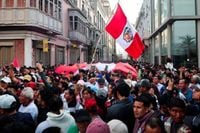Peru’s political landscape was once again thrown into turmoil in the early hours of October 10, 2025, as Congress voted overwhelmingly to remove President Dina Boluarte from office. The ousting of Boluarte, who became the country's first female president in late 2022, marks yet another chapter in a saga of chronic instability that has defined Peruvian politics for nearly a decade. The move came after months of mounting discontent over her government’s ability—or, as critics argue, inability—to address surging crime and public safety concerns, with the final straw being a deadly shooting at a concert in Lima linked to extortion gangs.
The impeachment proceedings, which culminated in a late-night session, saw 124 out of 130 lawmakers vote in favor of Boluarte’s removal, citing "moral incapacity" under the Peruvian Constitution. According to Reuters, this level of consensus cut across the political spectrum, with even conservative factions and parties that once supported Boluarte, such as Lopez Aliaga’s Popular Renewal, lending their votes to oust her. This was a stark contrast to the eight previous failed attempts to remove her from office.
Boluarte’s presidency had been on shaky ground from the start. She rose to power in December 2022 after the impeachment and arrest of her predecessor, Pedro Castillo, who had tried to dissolve Congress in a last-ditch effort to avoid his own removal. In her less than three years in office, Boluarte’s approval ratings languished at historic lows—between 2% and 4%, according to BBC—making her one of the world’s least popular leaders.
Her administration was beset by scandal and controversy. Among the most damaging was the so-called “Rolexgate” investigation, which centered on allegations that she accepted luxury watches as bribes. Another probe questioned whether she abandoned her post during a nose surgery by failing to appoint a caretaker president. She also faced accusations of illicit enrichment and was criticized for doubling her salary in July 2025 to nearly 35 times the minimum wage, a move that was met with widespread public scorn. Throughout, Boluarte denied any wrongdoing.
Perhaps most damning, however, was her handling of anti-government protests. In January 2023, an inquiry was launched into Boluarte and several key ministers on charges of genocide, qualified homicide, and serious injuries after a government crackdown on demonstrations left more than 50 supporters of former President Castillo dead. In the first three months of her presidency alone, Peru saw over 500 protests, with recurring unrest punctuating her tenure.
In a national television address following the vote, Boluarte questioned the implications her removal would have on the stability of Peru’s democracy. "At all times I have called for unity," she told Peruvians, adding: "In this context, I had not thought of myself but of the more than 34 million Peruvians who deserve better." Her words, however, did little to quell the celebrations outside Congress, where protesters brandishing Peruvian flags erupted in cheers as the announcement was made.
With Boluarte’s removal, Congress leader José Jerí was sworn in as interim president, as required by the absence of a vice president. Jerí, a 38-year-old conservative, now faces the daunting task of guiding Peru through a period of heightened insecurity and political uncertainty, all while maintaining neutrality ahead of the scheduled April 12, 2026, presidential elections. As Americas Quarterly notes, Jerí’s mandate is complicated by his own links to the traditional political elite and unresolved allegations of sexual abuse and corruption.
The road ahead is anything but straightforward. Peru has now averaged one and a half presidents per year since 2018, with Boluarte being the sixth leader since that time. Three former presidents are currently behind bars, underscoring the relentless churn at the top of Peruvian politics. According to Reuters, the electoral jury has approved 39 parties and alliances to field candidates in what is shaping up to be a highly polarized contest. Presidential hopefuls must resign from their current posts six months before the April election and have until December 23, 2025, to register their candidacies.
This revolving door of leadership has had profound consequences for Peru’s institutions and its people. Chronic instability has eroded public faith in government, fueled policy inconsistency, and made it difficult to address the country’s most pressing challenges. Organized crime and extortion have surged, with the recent concert shooting in Lima serving as a grim reminder of the stakes. Social grievances, from mining disputes to environmental protests, remain unresolved, while recurring corruption scandals continue to sap investor confidence and hinder economic development.
Economically, Peru performed relatively well in the first half of 2025, growing by 3.4% thanks to strong commodity prices. However, this momentum is expected to slow, with national GDP growth projected to average 2.7% in 2025 and 2.6% in 2026, according to Americas Quarterly. Analysts warn that unless the root causes of corruption, institutional weakness, and rising violence are addressed, leadership changes alone will not resolve the ongoing crisis.
As the country heads toward its next presidential election, the field is wide open. The electoral jury’s approval of 39 parties and alliances—from across the political spectrum—signals a campaign that will likely be as fragmented and contentious as ever. The absence of a vice president, the rapid turnover of leaders, and the imprisonment of former presidents all serve as stark reminders of the fragility of Peru’s democracy. Neighboring countries, too, are watching closely; Chile, for instance, is preparing for its own polarized election, with migration and security dominating the agenda.
For Peruvians, the hope is that the upcoming elections will offer a genuine opportunity for renewal and reform. Yet, as many analysts caution, the real test will be whether the next government can restore trust in institutions, implement effective anti-corruption measures, and bring lasting stability to a nation weary of political upheaval. The stakes could hardly be higher: without meaningful change, Peru risks remaining trapped in a cycle of crisis and disappointment for years to come.
In the end, the removal of Dina Boluarte is less a conclusion than a turning point. As the country braces for another pivotal election, the question on everyone’s mind is whether this time, real change will finally take root.

